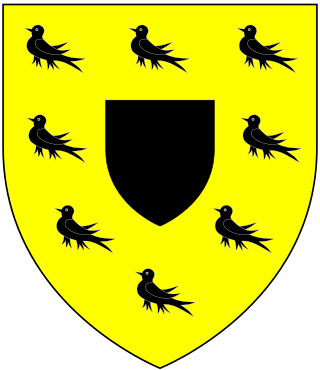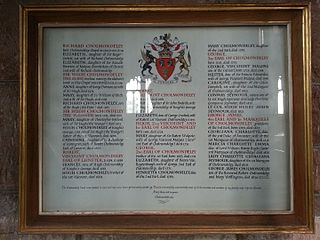
The Pate Baronetcy, of Sysonby in the County of Leicester, was a title in the Baronetage of England. It was created on 28 October 1643 for John Pate. The title became extinct on his death in 1659.

The Pate Baronetcy, of Sysonby in the County of Leicester, was a title in the Baronetage of England. It was created on 28 October 1643 for John Pate. The title became extinct on his death in 1659.
Baron Acton, of Aldenham in the County of Shropshire, is a title in the Peerage of the United Kingdom. It was created on 11 December 1869 for Sir John Dalberg-Acton, 8th Baronet, a prominent historian and Liberal Member of Parliament.
Baron Wrottesley, of Wrottesley in the County of Stafford, is a title in the Peerage of the United Kingdom. It was created on 11 July 1838 for Sir John Wrottesley, 9th Baronet. He was a Major-General in the Army and also represented Lichfield, Staffordshire and Staffordshire South in House of Commons. The Wrottesley family's original patronymic was 'de Verdun', which meant that the creation of the title Baron Wrottesley represented the third barony created by a branch of the de Verdun family in England. The other two were established by Theobald de Verdun, 1st Baron Verdun of Alton Castle and Sir John de Verdon, 1st Baron Verdon, lord of Brixworth in Northamptonshire and Bressingham in Norfolk.

Baron Poltimore, of Poltimore in the County of Devon, is a title in the Peerage of the United Kingdom. It was created in 1831 for Sir George Bampfylde, 6th Baronet. His son, the second Baron, held office as Treasurer of the Household from 1872 to 1874 in the first Liberal administration of William Ewart Gladstone.

Earl of Sussex is a title that has been created several times in the Peerages of England, Great Britain, and the United Kingdom. The early Earls of Arundel were often also called Earls of Sussex.
There have been ten baronetcies created for persons with the surname Browne, six in the Baronetage of Great Britain, three in the Baronetage of Ireland and one in the Baronetage of Nova Scotia. Only one creation is extant as of 2010. Three of the creations were for members of the Browne family headed by the Viscount Montagu.

Viscount Tyrconnel was a title in the Peerage of Ireland. It was created in 1718 for Sir John Brownlow, 5th Baronet, Member of Parliament for Grantham and Lincolnshire. He was made Baron Charleville, in the County of Cork, at the same time, also in the Peerage of Ireland. The Brownlow Baronetcy, of Humby in the County of Lincolnshire, was created in the Baronetage of England on 27 July 1641 for William Brownlow. His grandson, the third Baronet, represented Grantham in Parliament. The latter had no surviving male issue and was succeeded by his younger brother, the fourth Baronet. He sat as Member of Parliament for Peterborough and Bishop's Castle. He was succeeded by his son, the aforementioned fifth Baronet, who was elevated to the Peerage of Ireland as Viscount Tyrconnel. The three titles became extinct on Lord Tyrconnel's death in 1754. The Brownlow estates were passed on to the late Viscount's nephew, Sir John Cust, 3rd Baronet, whose son was created Baron Brownlow in 1776.

There have been two baronetcies created for members of the Brownlow family, both in the Baronetage of England. Both titles are now extinct.

The Adams Baronetcy, of London, was a title in the Baronetage of England. It was created on 13 June 1660 for Thomas Adams, Lord Mayor of London in 1645. The title presumably became extinct on the death of the sixth baronet in 1770.

Robert Cholmondeley, 1st Earl of Leinster, was an English Royalist and supporter of Charles I during the English Civil War.

Sir John Brownlow, 3rd Baronet of Belton House near Grantham in Lincolnshire, was an English member of parliament. He built the grand mansion of Belton House, which survives today.

There have been twenty one baronetcies created for persons with the surname Williams, eight in the Baronetage of England, three in the Baronetage of Great Britain and ten in the Baronetage of the United Kingdom. Only six of the creations are extant as of 2017.
There have been four baronetcies created for people with the surname Lee, all extinct.

There have been two baronetcies created for members of the St Aubyn family, one in the Baronetage of England and one in the Baronetage of the United Kingdom.
There have been two baronetcies created for members of the Reade family, both in the Baronetage of England. Both creations are now extinct.
The Winchcombe Baronetcy, of Bucklebury in the County of Berkshire, was a title in the Baronetage of England. It was created on 18 June 1661 for Henry Winchcombe. The second Baronet sat as Member of Parliament for Berkshire. The title became extinct on his death in 1703. The Winchcombe estates passed to his eldest daughter, Frances Winchcombe, wife of Henry St John, 1st Viscount Bolingbroke.

The Prideaux Baronetcy, of Netherton in the County of Devon, was a title in the Baronetage of England. It was created on 17 July 1622 for Edmund Prideaux. The third Baronet sat as member of parliament for Liskeard and St Mawes. The fourth Baronet was member of parliament for Tregony. The title became extinct on the death of the ninth Baronet in 1875.
The Bunce Baronetcy, of Otterden in the County of Kent, was a title in the Baronetage of England. It was created in May 1660 for Sir James Bunce, Sheriff of the City of London from 1643 to 1644. The title became either extinct or dormant on the death of the sixth Baronet in 1741.
The Castleton Baronetcy, of St Edmundsbury in the County of Suffolk, was a title in the Baronetage of England. It was created on 9 August 1641 for William Castleton, High Sheriff of Suffolk from 1641 to 1642. The second Baronet was High Sheriff of Suffolk from 1660 to 1661. The sixth Baronet was Rector of Gillingham, Norfolk. The eleventh Baronet was Rector of Thornham, Norfolk. The title became extinct on the death of the twelfth Baronet in 1810.
John Pate (1632-1672) was a planter and politician who invested in land in and around Gloucester County and in his last years served on the Virginia Governor's Council.
Thomas Pate was a British merchant who became a planter, military officer, ferry owner and politician who served a term as burgess representing Gloucester County in the House of Burgesses. Rebel Nathaniel Bacon commandeered this man's house in Gloucester County during Bacon's Rebellion, and later Governor Howard also lived there. Across Mobjack Bay, the restored historic Yorktown home once named after this man is now renamed the "Cole Digges" house after a politically powerful successor owner and resident since recent archeological research indicates it was probably built decades after this man's death.